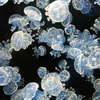Sensory Mechanisms PDF
Document Details

Uploaded by RapturousGyrolite5789
Tags
Summary
This document describes different types of sensory mechanisms, including mechanoreceptors, chemoreceptors, electromagnetic receptors, thermoreceptors, and nociceptors. It also highlights how sensory systems work, using examples like the auditory canal and touch receptors..
Full Transcript
respond to a stimulus, stimulus must be recognized 3 different organizations receptor p...
respond to a stimulus, stimulus must be recognized 3 different organizations receptor potential: when changing membrane strong stimulus 1. clustered or singular = more receptor potential potential creates a graded signal 2. widespread or localized = more action potential generated 3. respond to internal/external signals sensory reception: detection of a stimulus by How it Works stimulus must depolarize membrane 4. be sensitive or not (differs between species) sensory cells will open specific ion channels Sensory Receptors can alter the frequency of stimulus to become more amplified mechanoreceptors: physical (movement & hearing) general sense found throughout body chemoreceptors: chemical (smell, taste) location of touch electromagnetic receptors: light (vision) - weight, temperature, presence of pain types of recognized stimuli - aka photoreceptors Merkel disks: detect light touch & superficial Touch pressure Hair follicle receptor: detects light touch thermoreceptors: temperature (touch) nociceptors: pain Meissner corpuscles: fine, discriminative touch Sensory Mechanisms Ruffini corpuscle: continuous touch/pressure auditory canal converts air waves into fluid Pacinian corpuscle: detects deep pressure, waves vibration, and position Hearing And Balance transmit information through ears to make sense of sounds odor detection - amount of receptors - sensitivity of receptors light is sensed by photoreceptors in the eyes Olfaction mainly sensed in the nasal cavity via olfactory 3 layers bulbs 1. sclera: protection 2. choroid: blood flow 3. retina: photoreceptors Sight purpose: see if food is safe to eat blind spot: region in retina that connects to optic nerve (has no photoreceptors) Gustation 5 tastes 1. sweet sides 2. sour - see everywhere except front 3. salty eyes can be on sides or on front 4. bitter 5. unami (savory) front - amazing depth perception